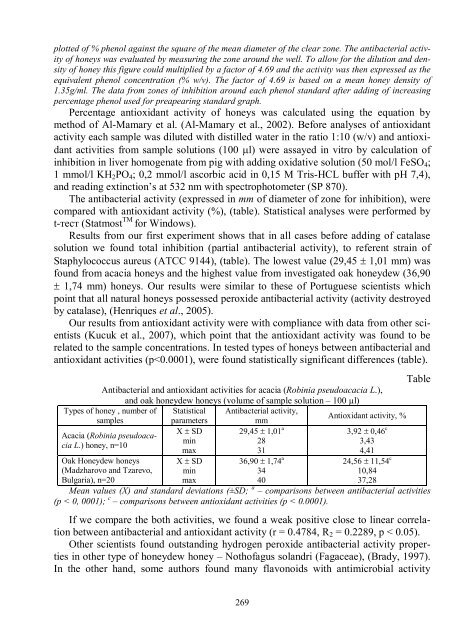n - Кафедра Прикладная биотехнология
n - Кафедра Прикладная биотехнология
n - Кафедра Прикладная биотехнология
You also want an ePaper? Increase the reach of your titles
YUMPU automatically turns print PDFs into web optimized ePapers that Google loves.
plotted of % phenol against the square of the mean diameter of the clear zone. The antibacterial activity<br />
of honeys was evaluated by measuring the zone around the well. To allow for the dilution and density<br />
of honey this figure could multiplied by a factor of 4.69 and the activity was then expressed as the<br />
equivalent phenol concentration (% w/v). The factor of 4.69 is based on a mean honey density of<br />
1.35g/ml. The data from zones of inhibition around each phenol standard after adding of increasing<br />
percentage phenol used for preapearing standard graph.<br />
Percentage antioxidant activity of honeys was calculated using the equation by<br />
method of Al-Mamary et al. (Al-Mamary et al., 2002). Before analyses of antioxidant<br />
activity each sample was diluted with distilled water in the ratio 1:10 (w/v) and antioxidant<br />
activities from sample solutions (100 �l) were assayed in vitro by calculation of<br />
inhibition in liver homogenate from pig with adding oxidative solution (50 mol/l FeSO4;<br />
1 mmol/l KH2PO4; 0,2 mmol/l ascorbic acid in 0,15 M Tris-HCL buffer with рН 7,4),<br />
and reading extinction’s at 532 nm with spectrophotometer (SP 870).<br />
The antibacterial activity (expressed in mm of diameter of zone for inhibition), were<br />
compared with antioxidant activity (%), (table). Statistical analyses were performed by<br />
t-тест (Statmost TM for Windows).<br />
Results from our first experiment shows that in all cases before adding of catalase<br />
solution we found total inhibition (partial antibacterial activity), to referent strain of<br />
Staphylococcus aureus (ATCC 9144), (table). The lowest value (29,45 � 1,01 mm) was<br />
found from acacia honeys and the highest value from investigated oak honeydew (36,90<br />
� 1,74 mm) honeys. Our results were similar to these of Portuguese scientists which<br />
point that all natural honeys possessed peroxide antibacterial activity (activity destroyed<br />
by catalase), (Henriques et al., 2005).<br />
Our results from antioxidant activity were with compliance with data from other scientists<br />
(Kucuk et al., 2007), which point that the antioxidant activity was found to be<br />
related to the sample concentrations. In tested types of honeys between antibacterial and<br />
antioxidant activities (p



